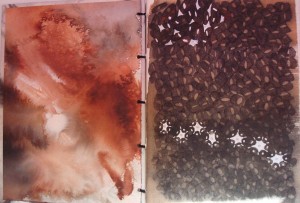As an artist, one gets asked a lot about where the ideas come from, why did you do this, or what made you think of that. The simple answer is that there is no simple answer. For me, it’s about color, shape and line, the feel of the brush on the paper or canvas, the shape of the text.
When you look at the shadows on the snow, what do you see? The myriad colors of blues and grey? The textures of the branches? Or do you simply feel the cold winter air? Each of us visualizes differently. There is no one right way to make art.
 As an artist who uses letters, occasionally I begin work with a text, but more often the text seems to flow directly from the colors and shapes on the page. Personally I find that this can make all the difference between writing words on a page and text that becomes a part of the art.
As an artist who uses letters, occasionally I begin work with a text, but more often the text seems to flow directly from the colors and shapes on the page. Personally I find that this can make all the difference between writing words on a page and text that becomes a part of the art.
Our western tradition of illustration is one that often separates the art from the text. Books often have authors and illustrators. But what if the text is the art? What then?
The computer age has forced us to rethink the place of calligraphy in our lives. This is hardly a new concept. Handwritten letters as a means of communication has been becoming redundant since Gutenberg’s moveable type.
But that doesn’t mean letters aren’t important. Brody Neuenschwander’s translation of Hans-Joachim Burgert’s writing, The Calligraphic Line is a wonderful introduction to viewing letters in the context of graphic forms.
In answer to the original question, where does a lettering artist derive inspiration, the answer lies from within. So instead of sitting around waiting for that perfect quotation, just pick up your pen or brush and begin. Let the letters inspire.

















